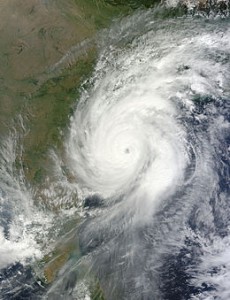Spring Trekking Weather, Nepal, April and May
By Michael FaginEverest Basecamp, Mt. Everest Weather, Trekking Everest, Trekking Nepal
You do not want to trek during a “big storm.” Photo credit Wikipedia, the free encyclopedia
Spring Trekking Weather, Nepal, April and May. Spring tends to be popular for trekkers through Nepal as it precedes the monsoon season which generally starts in June. We will briefly look at the weather patterns for Western Nepal where the treks begin for the Annapurna Circuit. Then, Central Nepal, in the vicinity of Kathmandu and then jump to Lukka where treks to the Everest Base Camp begin. Then finally, to Gangtok, which is in India, but is the closest weather station for the Kangchenjunga Circuit treks.
Because the cities, and most weather stations lie at a lower elevation than the trek areas it is good to remember that temperatures will be cooler. On average temperatures decrease by 3.0 degrees F or 1.7 C for every 1,000 feet or 300 meters in elevation gain.
Pokhara, at 2,145 feet, (600 meters), has an average high temperature in April of 86 F, (30 C), and average low of 60 F, (15.5 C), with precipitation of 5 inches, (125 MM). May averages are 14 inches of precipitation, (359 MM), with low temperatures of 65 F, (18.5 C). July, in the monsoon sees 37.5 inches or, 940 MM of precipitation. Annually 156 inches of precipitation is expected, ( 3,901 MM). One day in August of 2001 14 inches, ( 357 MM ) fell. Making the monsoon season a time to be avoided.
between June and September.
Kathmandu, at 4,297 feet, (1,310 meters), has an average April high of 82 F, (28 C), and average low of 53 F, (12 C) with precipitation of 2.4 inches, (60 MM). May sees highs of 84 F, (29 C), and lows of 6 F, (16 C), with precipitation of 5 inches, (124 MM). Annual precipitation is 58 inches, (1454 MM).
Gangtok. India at 5,280 feet, 1600 meters, has highs in April of 70 F, (21 C) and in May of 71 F, (22 C). Precipitation in April of 11 inches, (289 MM). Average lows in April are 52 F, (11 C) and May, 56 F, (13.5 C). with 22 inches, (553 MM), of precipitation. Annual rainfall is 145 inches, (3626 MM).
For basic rainfall patterns. Also of interest mountains create rain shadows in different regions.
Accurate forecasts are essential to the trekker and especially the climber. Any expedition should be prepared of course, for all kinds of weather. Some treks manage quite well in T shirts and shorts while the next may have rain and snow storms with which to cope. Wind chill at elevation may quickly lead to hypothermia if not outright frostbite. Staying mindful of local conditions and the short term forecasts is a requirement for a safe journey to a fascinating land.
Another useful on El Nino.
Written by Robert Morthorst and edited by Operational Meteorologist Michael Fagin.
